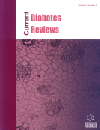- Home
- A-Z Publications
- Current Diabetes Reviews
- Previous Issues
- Volume 9, Issue 1, 2013
Current Diabetes Reviews - Volume 9, Issue 1, 2013
Volume 9, Issue 1, 2013
-
-
Diabetic Retinopathy Screening by General Practitioners Using Non- Mydriatic Retinography
More LessAuthors: Monica Perez-de-Arcelus, Jose Andonegui, Luis Serrano, Aitor Eguzkiza and Jose Ramon MayaDiabetic retinopathy (DR) is the leading cause of visual loss in people aged 30 to 69 years. Most authorities recommend screening of the ocular fundus to prevent severe visual loss. The increasing incidence of diabetes mellitus and fewer ophthalmologists in many countries is leading to inadequate screening. Establishing an adequate system for DR screening is a complex issue and represents a challenge for most health Read More
-
-
-
The Management of the Infected Diabetic Foot
More LessDiabetes is a chronic disease with a worldwide increasing trend. Foot complications, closely related to neuropathy and obstructive peripheral vascular disease, are responsible for more than 1 million of leg amputations every year. Foot infection can dramatically increase the risk of amputation. Although many ulcer classification systems have been proposed to stratify the severity of the infectious process, the definiti Read More
-
-
-
Regulation of Insulin Synthesis and Secretion and Pancreatic Beta-Cell Dysfunction in Diabetes
More LessAuthors: Zhuo Fu, Elizabeth R. Gilbert and Dongmin LiuPancreatic β-cell dysfunction plays an important role in the pathogenesis of both type 1 and type 2 diabetes. Insulin, which is produced in β-cells, is a critical regulator of metabolism. Insulin is synthesized as preproinsulin and processed to proinsulin. Proinsulin is then converted to insulin and C-peptide and stored in secretary granules awaiting release on demand. Insulin synthesis is regulated at both the transcriptional and transl Read More
-
-
-
Prevalence of Diabetes Ketoacidosis Rises and Still No Strict Treatment Adherence
More LessAuthors: Alex Jervis, Susannah Champion, Gemma Figg, Jane Langley and Gary G. AdamsDiabetes ketoacidosis (DKA) should be managed following clear written guidelines. However, evidence suggests that healthcare professionals do not always adhere strictly to the agreed guidelines. Objective: This investigation aimed to review the management of DKA in a hospital setting, to assess what DKA treatment was implemented and its effectiveness on patient care. As a result of the study, it was also anticipated that t Read More
-
-
-
Current Update in the Management of Diabetic Nephropathy
More LessAuthors: Peter Noel Van Buren and Robert TotoDiabetic nephropathy is the leading cause of end-stage renal disease in the United States. The progression of kidney disease in patients with diabetes can take many years, and interventions such as glycemic control, blood pressure control, and inhibition of the renin-angiotensin-aldosterone system have been shown to slow this progression. Despite the implementation of these strategies, the number of patients w Read More
-
-
-
New-onset Diabetes Mellitus: Predictive Factors and Impact on the Outcome of Patients Undergoing Liver Transplantation
More LessLiver transplantation (LT) for hepatocellular carcinoma (HCC) is the treatment of choice for patients with tumor characteristics within the Milan criteria associated with Child B or C cirrhosis. LT provides the best cure for both the tumor and the cirrhosis. There have been several emerging reports that new-onset diabetes mellitus (NODM) after transplantation (NODAT) is one of the most negative predictive factors for low sur Read More
-
-
-
Genetics and Diabetic Retinopathy
More LessAuthors: Stephen G. Schwartz, Milam A. Brantley and Harry W. FlynnThere are many reasons to suspect a genetic influence on the development and progression of diabetic retinopathy, including substantial variability in disease severity among patients with similar risk factors. Linkage studies have suggested associations with chromosomes 1, 3, 12 and others. The most studied individual genes are those encoding vascular endothelial growth factor, aldose reductase, and the receptor for advanc Read More
-
Volumes & issues
-
Volume 21 (2025)
-
Volume 20 (2024)
-
Volume 19 (2023)
-
Volume 18 (2022)
-
Volume 17 (2021)
-
Volume 16 (2020)
-
Volume 15 (2019)
-
Volume 14 (2018)
-
Volume 13 (2017)
-
Volume 12 (2016)
-
Volume 11 (2015)
-
Volume 10 (2014)
-
Volume 9 (2013)
-
Volume 8 (2012)
-
Volume 7 (2011)
-
Volume 6 (2010)
-
Volume 5 (2009)
-
Volume 4 (2008)
-
Volume 3 (2007)
-
Volume 2 (2006)
-
Volume 1 (2005)
Most Read This Month
Article
content/journals/cdr
Journal
10
5
false
en


